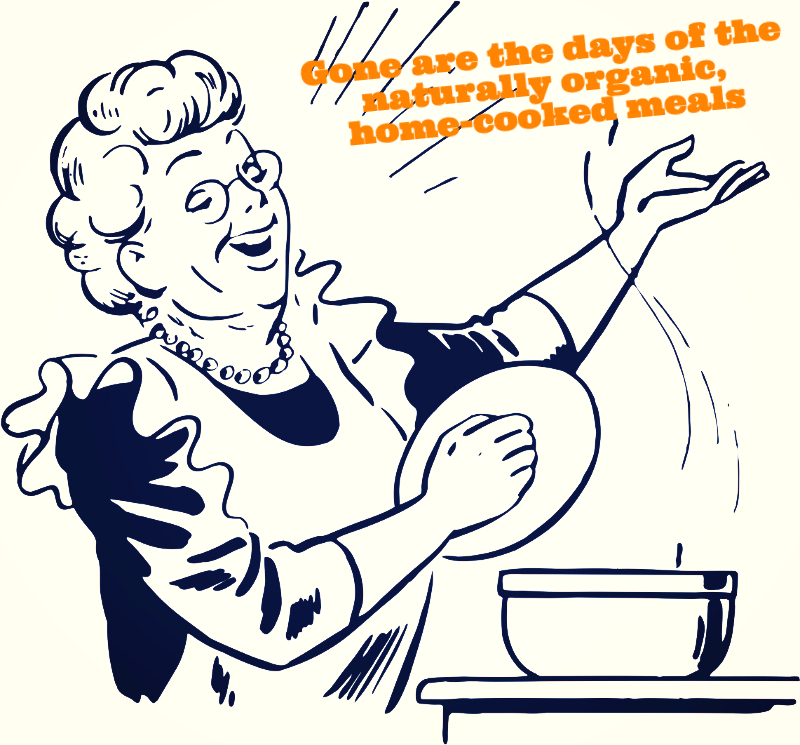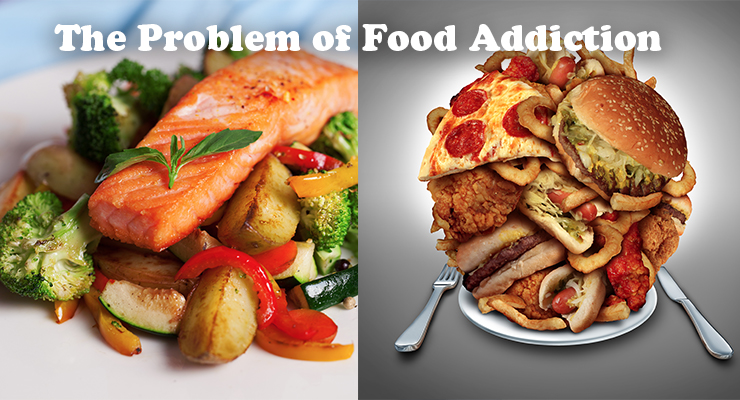Question:
Quick … what is more powerful than the world’s largest electromagnet?
Answer:
A bag of Nacho Cheese Doritos, of course. This attraction actually has a name. Its called the “Dorito Effect”.
Food Addiction Is Real
We live in an obesogenic society. The term “obesogenic environment” refers to “an environment that promotes gaining weight and one that is not conducive to weight loss” within the home or workplace (Swinburn, et al., 1999). This has been a well researched topic for many years now.
 With the disappearance of the wellness of home-cooked meals made with wholesome, naturally organic ingredients, a new society has emerged where staying healthy has become a daily struggle against the senses. The shelves remain loaded with “designed” foods that are having a toxic effect on an oblivious society.
With the disappearance of the wellness of home-cooked meals made with wholesome, naturally organic ingredients, a new society has emerged where staying healthy has become a daily struggle against the senses. The shelves remain loaded with “designed” foods that are having a toxic effect on an oblivious society.
“A new society has emerged where staying healthy has become a daily struggle against the senses”
“Mark Schatzker, an award-winning journalist, provides the latest support for the fact that we may all be involved in a mass dietary manipulation experiment/hypnosis without even knowing it. Specifically, our food may be more of a science experiment-gone-bad than a source of nourishment. Schatzker’s emphasis is on how the nation’s epidemics of obesity, heart disease, and diabetes may not be tied to any specific macronutrient (fat, carbs, protein), but more to the addictive properties of processed foods and flavorings that have flooded our food supply. Furthermore, as junk foods have increased in amounts of enticing flavoring chemicals, our nutritious food grows blander and less nutritious, making our chickens less tasty and our veggies less appealing.” (source: via Can Food Be An Addiction? – Part 1)
A greater knowledge has led to the market to respond by loading the shelves with alternative foods with now commonplace buzzword labels such as organic, cage-free, free range, grass-fed, hormone-free, gluten-free etc.
But that’s not enough. Even within these new food classifications, confusion reigns supreme. What is really organic? Is our image of “cage-free” being that of chickens roaming wild on open fields, or somewhat different? And while we are thinking of all that, the allure of the bag of chips remains a distraction that must be fought – or, in that act of final transgression, must be succumbed to – over and over again.
Food Addiction Is Not a Matter of Self-Control
Sarah Lo Bisco, ND in the Designs for Health blog quotes Pulitzer Prize winning Michael Moss in his book, “Salt, Sugar, Fat: How the Food Giants Hooked Us” where he states, “By concentrating fat, salt and sugar in products formulated for maximum ‘bliss, Big Food has spent almost a century distorting the American diet in favor of calorie-dense products whose consumption pattern has been mirrored by the calamitous rise in obesity rates. Entire food categories were invented to support this strategy…”
Dr. David Kessler, Former FDA Commissioner calls it “conditioned hypereating” resulting from a biological challenge made more difficult by the overstimulating food environment that surrounds us” rather than willpower.
There is a strategy behind the whole thing that has been developed over decades to slowly breakdown the powerful human will. Steven Witherly describes six pleasure theories in his book “Why Humans Like Junk Food” including Taste Hedonics (salt, sugar, umami), Dynamic Contrast (food arousal and surprise), Evoked Qualities (food sensory perceptions connected to past memories – a.k.a. addiction?), Food Pleasure Equation (Food Pleasure = Sensation + Macronutrients), Caloric Density (calories per unit food – cup, spoon, ounce, etc.) and Emulsion Theory (taste buds prefer food in emulsified forms).
All these categories explain why we like pizza, burgers, tortilla chips, ice cream, butter, southern fried chicken, french fries, spices, chocolate, diet soda, popcorn, donuts … should I go on? (Note: This is not the time for a dash to the refrigerator for that left over pizza, please read on).
And The Survey Says …
Check out this Nielsen survey results:
In 2013-14, an overwhelming 45% of 30,000 global respondents across 60 countries said that fresh fruit is their snack of choice over a variety of other snacks – declaring that natural ingredients were more important to them. However, the overwhelming majority of the world’s snack budgets ($374 billion) belies that statement since it was spent on sugary sweets, salty snacks, refrigerated foods (not frozen vegetables, in case you were wondering), cookies and snack cakes – not just in the USA, but across the world.
Does this mean that the world is full of people who have lost their ability to control themselves? Or is there something else going on? It is clear that the world has been slowly addicted to foods that are causing health challenges, the reversal of which can be equivalent or worse than trying to undo drug addiction.
Food Addiction 101: The Brain Responds to Chemicals
Dr. Michael Cutler describes the plight of a patient who worked graveyard shifts and was suffering from acid reflux and other symptoms. On questioning further, this patient revealed that she was addicted to Coca-Cola.
Why is it so hard to digest that food can be an addiction?
The answer lies in the brain and the chemicals it responds to everyday. We all know that drug addiction and a loss of brain control typically go together. The brain responds to specific chemicals and gets used to them, craving more of the same when you stop the supply. These chemicals alter the way the brain functions, leading to imbalances in the body and behavior modification.
Sugars and trans-fats have a similar effect on the brain – except that they turn out to be worse than drugs! Like Pavlov’s trained dogs, our brain keeps on wanting more of these addictive foods, and reacts unfavorably when they are withdrawn. If you cannot tame the cravings, you will go right back to eating the same things that caused the problem in the first place. The fact that these foods are socially accepted (and mostly encouraged) makes the situation even worse.
Taming that craving is not as easy as simply exercising willpower, especially if the brain has been conditioned for long enough. The strong neural pathways created through the addiction process can be reversed, but they have to be allowed to fade away through disuse as new, healthier pathways are put in place. That is the hardest part of overcoming any addiction – food included.
Food Addiction 101: Connection to Emotional Stress & Neurotransmitter Hormones
Dr. Cutler states, “Craving nutritional food is natural when you get hungry. But for most of you, craving unhealthy food is particularly strong the more emotionally stressed you are. That’s because unhealthy foods bring instant pleasure and cause your brain dopamine to surge.”
Dopamine is a neurotrasmitter that impacts the pleasure centers of the brain and sugar is connected with the increase in dopamine levels – so it all starts making sense now, doesn’t it? Sugar increases dopamine, dopamine makes you happy. Drop the dopamine, up go the sugar cravings!
Dr. Cutler describes the triple whammy: being hungry, stressed and having access to junk foods as being the perfect storm to continue with food addiction.
Another hormone to watch is serotonin. Serotonin levels fall with anxiety and depression. Sugars and trans-fats raise serotonin levels, making us feel better. However, this effect is temporary. To induce this temporary effect, the pathways that “want” sugar and trans-fats keep asking for more to sustain the right levels of serotonin, creating an addictive need.
Obesity is related to fat storage, and fat storage is related to a hormone called leptin. Sugar raises dopamine levels, which raises leptin levels, which, in turn, stores fat. To raise the dopamine levels again, you crave more sugar. Which results in more fat storage. And so the cycle goes on.
So you can see here that the battle is between our conscious mind at loggerheads with our sub-conscious, biochemically controlled mind. Anyone who knows anything about the brain can tell you that the conscious brain can only have temporary victories compared to the overwhelmingly powerful subsconscious mind. That is why simply knowledge is not enough.
More Addictive Ingredients
Its not just the sugars and the trans-fats. Processed foods are loaded with addictive chemicals in the form of additives and preservatives. Many of them are designed to stimulate appetite and increase cravings through their aroma and anticipated taste. Some of these additives are designed to keep you hungry, so you eat more. So that’s how the big bag of Doritos disappeared, huh?
The speed at which you eat doesn’t help the cause either, since the digestive system needs time to convey to the brain that it has received enough food and orders you to stop eating.
Sweeteners such as aspartame and sucralose also induce cravings. MSG (monosodium glutamate) is still added in many foods to make them taste good – inducing addiction. MSG was reported in August 20051 to cause a 40% weight increase in rats when dosed at an equivalent human dose. It also caused growth hormone suppression, which is related to accelerated aging. In mice, brain cell destruction was observed under the influence of MSG.
So, are we doomed to be food addicts? Is diabetes inevitably in our horizon? Not necessarily so. Overcoming food addiction first requires awareness, but for most of us, also requires a program.
In future articles, we will discuss this topic in more detail and give you options that will help you make good decisions! So stay tuned.
[1] Hermanussen M, Garcia AP, Sunder M, Voigt M, Salazar V, Tresguerres JA. Obesity, voracity, and short stature: the impact of glutamate on the regulation of appetite. Eur J Clin Nutr. 2005 Aug 31.


